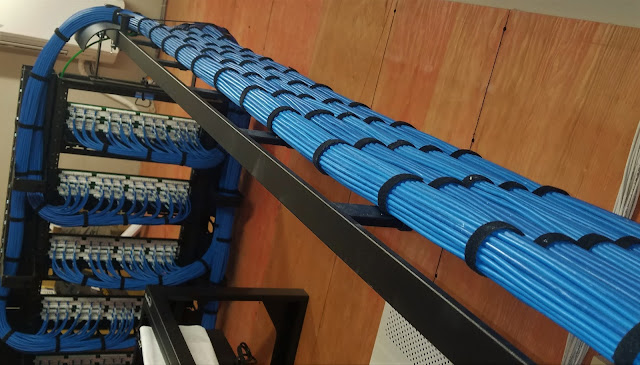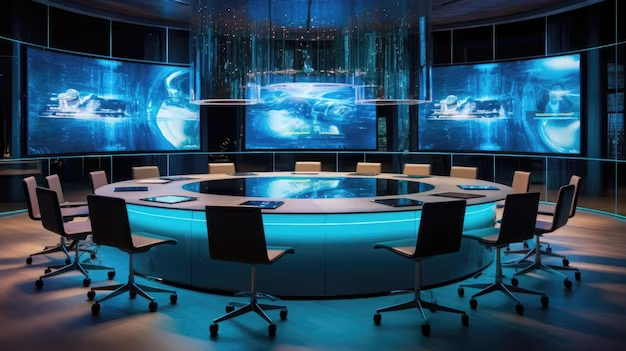Role of Audio Video Integrators in Healthcare Sectors
In the quiet corridors of a healthcare setting, where moments of
vulnerability meet the promise of healing, imagine a patient's journey
transformed by the gentle embrace of audio video
integrators. Picture a scenario where the soothing tones of carefully
curated sounds and the calming visuals of nature seamlessly intertwine,
creating an environment that transcends the clinical. This is the profound
impact of audio-video integration in healthcare—a synergy of technology and
compassion designed to elevate patient experiences to a new realm of comfort
and well-being.
As we embark on this exploration, let's first understand the essence
of audio-video integrators in healthcare and how they weave a tapestry of
healing for those in need. In essence, audio-video integrators are the
architects of sensory environments, employing sound and vision to craft spaces
that resonate with the human spirit. This amalgamation of technology and
empathy holds the promise of transforming healthcare settings into sanctuaries
of solace, where patients find not only treatment but a haven for restoration.
The Healing Power of Environments
In the realm of healthcare, the environment is a silent yet powerful
ally in the healing process. It is not merely the physical setting but a
nuanced orchestra of elements that influence the well-being of patients. The
lighting, the colors, and the ambiance—all play crucial roles in setting the
tone for healing.
As we contemplate the healing power of environments, we realize that
it goes beyond aesthetics; it encompasses the very essence of comfort and
reassurance. It is here that audio-video integrators step into the spotlight,
orchestrating an environment that transcends the clinical norm. Beyond the
sterile walls, they infuse spaces with therapeutic sounds and visuals that
resonate with the human spirit. The role of sound and vision becomes pivotal,
not just as embellishments but as essential components in the symphony of
healing.
Creating Immersive Patient Experiences
Patient Rooms
Within the confines of patient rooms, audio-video integrators unfold a
narrative of personalization and comfort. Imagine a patient entering a room
where the environment adapts to their preferences—soft melodies playing,
calming visuals on display—a personalized cocoon of solace. Here, audio-video
integration becomes a healing companion, addressing the emotional well-being of
patients alongside their physical needs.
Waiting Areas
The waiting areas, often tinged with anxiety and anticipation, undergo
a transformation through the thoughtful integration of audio and video
elements. Screens display calming scenes, interactive displays engage and
distract, and the ambient soundscape is curated to reduce tension. In this
transformed setting, the waiting area becomes a space of solace, a buffer
against the stresses that often accompany healthcare visits.
Soundscapes for Wellness
In the delicate tapestry of healthcare, where the soothing cadence of
sound becomes a healing balm, audio integrators step into the realm of
therapeutic sound design. Imagine the gentle rustle of leaves, the rhythmic
lapping of waves, or the harmonious melodies designed not merely for auditory
pleasure but as therapeutic companions. These soundscapes are meticulously
crafted to transcend the mundane, promoting relaxation and reducing the burden
of stress that often accompanies a healthcare journey.
As architects of auditory tranquility, audio integrators understand
that sound is not just heard; it is felt. The therapeutic soundscapes they
design aim not only to soothe but to create an atmosphere of calm resilience.
From the subtle hum of ambient tones to the strategic use of nature-inspired
sounds, these audio elements become the orchestrators of a symphony that
harmonizes with the healing process.
Visual Elements in Healing
In the canvas of healing, where the visual narrative is as crucial as
the auditory, audio-video integrators extend their creative prowess to the
realm of visuals. Nature-inspired visuals emerge as a powerful tool to create a
calming atmosphere within healthcare spaces. Picture expansive landscapes,
serene seascapes, and vibrant floral vistas seamlessly integrated into the
visual tapestry of patient rooms and waiting areas.
The role of nature-inspired visuals goes beyond mere aesthetics; it is
a therapeutic intervention in itself. These visuals are curated to evoke a
sense of calm, to transport patients from the clinical setting to a serene
natural haven. As patients immerse themselves in these visuals, a symbiotic
dance between nature and healing unfolds.
Beyond static visuals, interactive displays become portals of patient
education and engagement. Imagine a screen that not only displays vital health
information but responds to patient queries, providing a dynamic and
personalized learning experience. These interactive displays become bridges,
connecting patients with their healthcare journey in a way that transcends the
traditional doctor-patient interaction.
Enhancing Communication
Communication within healthcare settings is not merely about
exchanging information; it is a lifeline of understanding and support.
Audio-video integrators play a pivotal role in enhancing this vital aspect of
healthcare.
Patient-Caregiver Communication
In the realm of patient-caregiver communication, audio-video
integrators ensure that the exchange of information is not just audible but
empathetic. Imagine a scenario where healthcare providers seamlessly
communicate with patients, using audio-video technology to convey information
with clarity and compassion. This enhancement in communication is not just a
technological feat; it is a bridge that fosters trust and understanding.
Multilingual Support
Diversity is a hallmark of healthcare, and patients come from various
linguistic backgrounds. Audio-video technology steps in as a unifying force,
providing multilingual support to ensure that every patient, regardless of
their native language, can receive information in a manner that resonates with
them. From interactive interfaces to audio instructions, multilingual support
becomes an inclusive approach to healthcare communication.
Technological Advances in Healthcare Integration
In the ever-evolving landscape of healthcare, where innovation is the
heartbeat of progress, audio-video integrators usher in technological marvels
that transcend conventional boundaries.
Virtual Reality (VR) for Pain Management
Imagine a patient undergoing a medical procedure, their reality
transformed through the immersive embrace of virtual reality. In the realm of
pain management, audio-video integrators leverage VR technology to create
therapeutic environments that transport patients away from the discomfort of
medical treatments. Through carefully crafted virtual landscapes, patients find
solace, and the immersive distraction becomes a potent ally in alleviating
pain.
VR transcends the physical boundaries of healthcare, offering a portal
to worlds that go beyond the clinical. It's not merely a technological
addition; it's a compassionate intervention that redefines the pain management
journey for patients.
Telehealth Solutions
As the digital era unfolds, the role of audio-video integrators
extends beyond the confines of physical healthcare settings. Telehealth
solutions, facilitated by these integrators, become the bridge connecting
healthcare providers with patients in remote locations. Through seamless
audio-video connections, virtual consultations come to life, enabling
healthcare professionals to monitor and assess patients from afar.
Challenges and Considerations
In the pursuit of innovation, challenges arise, and considerations
become the compass guiding ethical and practical implementation.
Challenges in Implementing Audio Video Integrators
The integration of audio-video technology in healthcare settings,
while transformative, is not without its challenges. From the intricacies of
system compatibility to the potential for sensory overload, audio-video
integrators navigate these hurdles with a commitment to seamless experiences.
Challenges become opportunities for refinement, ensuring that the integration
process aligns with the unique dynamics of healthcare environments.
Considerations for Privacy and Compliance
In the realm of healthcare, where patient confidentiality is
paramount, privacy considerations become a cornerstone of audio-video
integration. Ensuring compliance with healthcare regulations and safeguarding
sensitive information are non-negotiable elements. Audio-video integrators work
hand in hand with healthcare institutions to implement solutions that not only
elevate patient experiences but also adhere to the highest standards of privacy
and compliance.
Conclusion
As we step back from the intricate dance of technology and healing,
the transformative role of audio-video integrators in healthcare environments
becomes vividly apparent.
Audio-video integrators are not mere technicians; they are architects
of experiences, sculptors of environments that resonate with the essence of
human well-being. From therapeutic soundscapes to virtual realms of pain
relief, their contributions go beyond the technical—they touch the very fabric
of patient experiences.
The journey does not end with the current state of innovation. The
potential for continued exploration and evolution in the realm of audio-video
integration is boundless. The canvas of healthcare awaits further strokes of
creativity, promising enhanced patient experiences and a future where the
integration of sound and vision becomes an integral part of the healing
narrative.
FAQ’s
How does audio-video integration contribute to patient well-being in
healthcare settings?
Audio-video integration plays a crucial role in creating therapeutic
environments by designing personalized soundscapes and visual elements. This
contributes to reducing stress, enhancing relaxation, and improving the overall
well-being of patients during their healthcare journeys.
Can you provide examples of how virtual reality (VR) is used for pain
management in healthcare through audio-video integration?
VR technology integrated by audio-video experts immerses patients in
virtual environments that distract from medical procedures, alleviating pain
and discomfort. Examples include virtual landscapes and experiences carefully
crafted to provide a therapeutic and immersive distraction during treatments.
How do audio-video integrators ensure patient privacy and compliance
with healthcare regulations in their implementations?
Audio-video integrators prioritize patient privacy by adhering to
strict healthcare regulations. They implement solutions with robust security
measures, ensuring the confidentiality of patient information. Compliance with
standards such as HIPAA (Health Insurance Portability and Accountability Act)
is a fundamental aspect of their considerations.
In what ways do interactive displays contribute to patient education
and engagement in healthcare environments?
Interactive displays serve as dynamic tools for patient education and
engagement. They go beyond static information, providing real-time interaction
and personalized learning experiences. Patients can actively participate in
their healthcare journey, accessing educational content, asking questions, and
fostering a more informed and engaged approach to their health.




Comments
Post a Comment